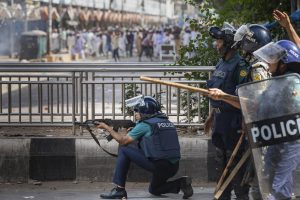On August 11, a high official in the Bangladesh police resigned, noting the force has transformed into a “public enemy.”
In his resignation letter, Md Moniruzzaman, an additional deputy inspector general with the Tourist Police in Khulna-Barisal, said, “Over the past 10 years, I was compelled to carry out illegal orders from ministers linked to the Awami League (AL) government.”
These orders, he added, were “brutal and barbaric,” designed to protect an unlawful regime and extend the power and financial gains of certain high-ranking officials.
Moniruzzaman’s resignation came at a time when Bangladesh was grappling with the aftermath of Prime Minister Sheikh Hasina’s ouster. Hasina had been in power since 2009, becoming Bangladesh’s longest-serving premier amid accusations of a growing authoritarian streak.
Hasina’s resignation and self-exile on August 5, driven by a massive student-led movement that started over the resurrection of quotas for government jobs, unleashed a wave of unrest across the South Asian nation. Amid the protests, not only Hasina’s government but also Bangladesh’s police force, long seen as an instrument of political repression, crumbled under the weight of public anger.
As jubilant crowds filled the streets to celebrate the end of Hasina’s rule, the situation quickly spiraled out of control, leading to widespread violence and the near-total collapse of law enforcement in Dhaka and beyond.
Even up until August 4, the police, alongside Hasina’s party activists, were brutally attacking protesters during demonstrations. The protests, which began in early July, resulted in the deaths of over 400 people – mainly students and ordinary citizens – and left tens of thousands wounded. The crackdown cemented the police’s image as “executioners.”
“The police force is packed with Hasina’s political partisans who did everything to uphold her fascist regime,” said Mahmud Ul Haque, a student activist from University of Dhaka. “They are the executioners of this genocide where hundreds of my brothers and sisters were brutally murdered and wounded. No human with a conscience can carry out such genocidal orders.”
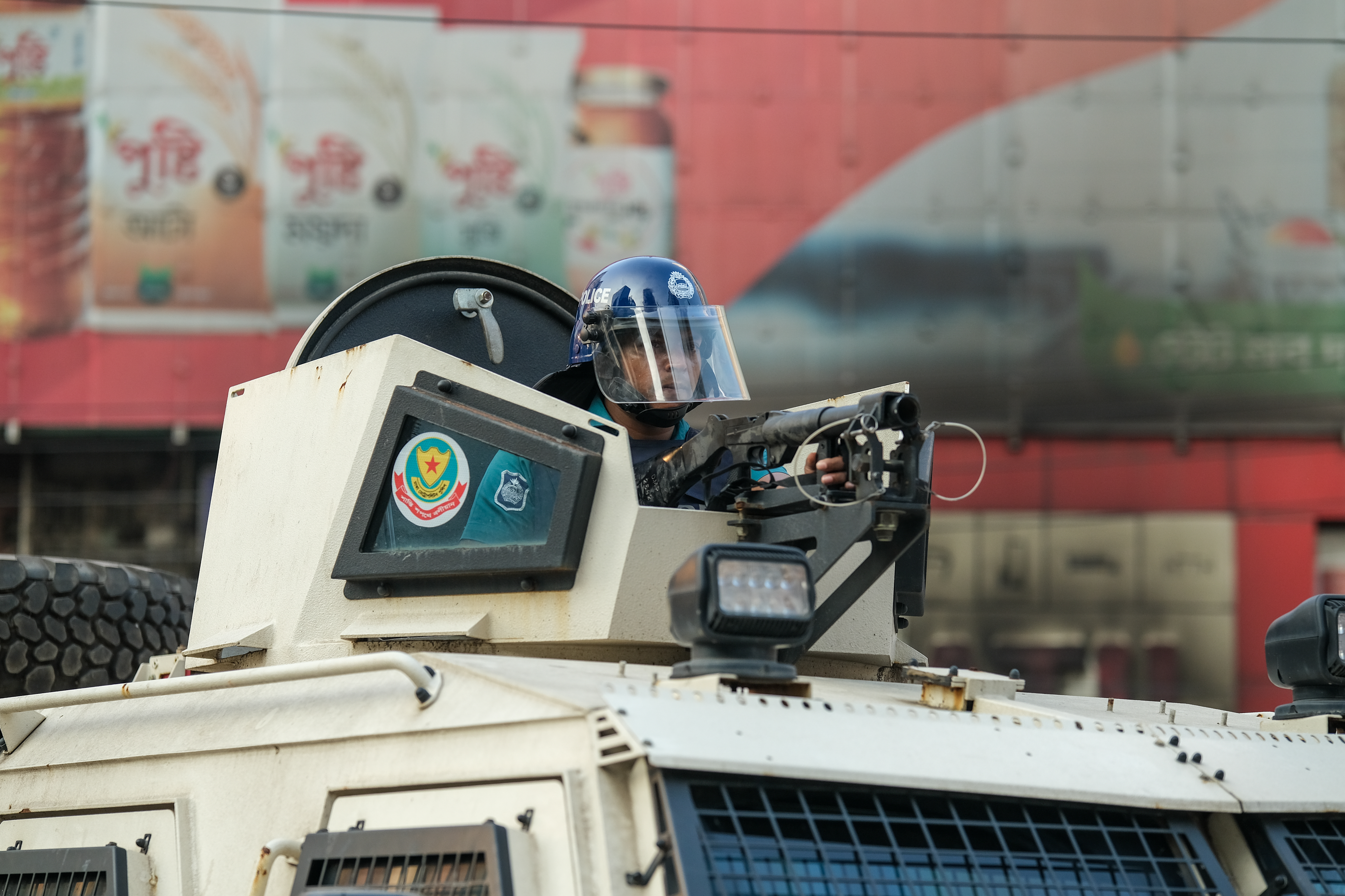
A police officer patrolling from an armored personnel carrier, aiming a gun toward the protesters. Photo by Saqlain Rizve.
A video of Abu Sayeed, an unarmed student, being shot to death at point-blank range by a policeman in the northern district of Rangpur, was just one of hundreds of videos circulating on social media that exposed the barbaric acts committed by police officers. The video of Sayeed’s murder, which later was verified by Amnesty International, has become a symbol of the “July Massacre.”
These videos, along with the accounts from the families of the deceased shared in local media, and the harrowing stories of wounded students – many of whom were struck in the eyes with pellets and suffered splinter injuries across their bodies – ignited widespread hatred for the police among ordinary people.
The police didn’t stop with the use of violence against protesters. They reportedly conducted block raids for a week, even when there were no active demonstrations, detaining over 11,000 people – of whom more than 85 percent were students and ordinary citizens, according to Dhaka Metropolitan Police (DMP) sources. All of the detainees were unconditionally released on August 6 upon the president’s order, but the gesture didn’t win any public goodwill for the police.
For years, the force – despite being oathbound to protect the people of Bangladesh – had been viewed as the muscle of the ruling Awami League party, especially during protests. While this summer’s protest movement marked a new high-water mark for the use of police violence, the force has long been known to use live ammunition, tear gas, and brutal force to quell peaceful dissent.
Now, with Hasina gone, the pent-up anger of the populace was unleashed on the very institution that had once kept them in check.
The most dramatic manifestation of this anger came immediately after Hasina’s resignation, when mobs attacked police stations across the country, setting them ablaze and clashing violently with officers. The Uttara East Police Station, one of the capital’s key law enforcement hubs, became a battleground by 6 p.m. on August 5, just hours after reports surfaced of Hasina’s airlift to India, which had long supported her government.
Hundreds of enraged citizens descended upon the station, overwhelming the officers inside. Eyewitnesses described the scene as chaotic, with plainclothes officers desperately firing tear gas and warning shots into the air in a futile attempt to disperse the crowd.
Tushar Abdullah, who was present during the attack, recalled the horror. “I saw people being shot and carried to the hospital,” he said. “It was like a war zone. People were screaming, running in all directions. I felt completely helpless.”
This wasn’t an isolated incident. Similar attacks were reported at police stations in Jatrabari, Tejgaon, Mohammadpur, and Khilgaon. Over 450 police stations across the country had been “attacked,” according to a statement by the Bangladesh Police Association.
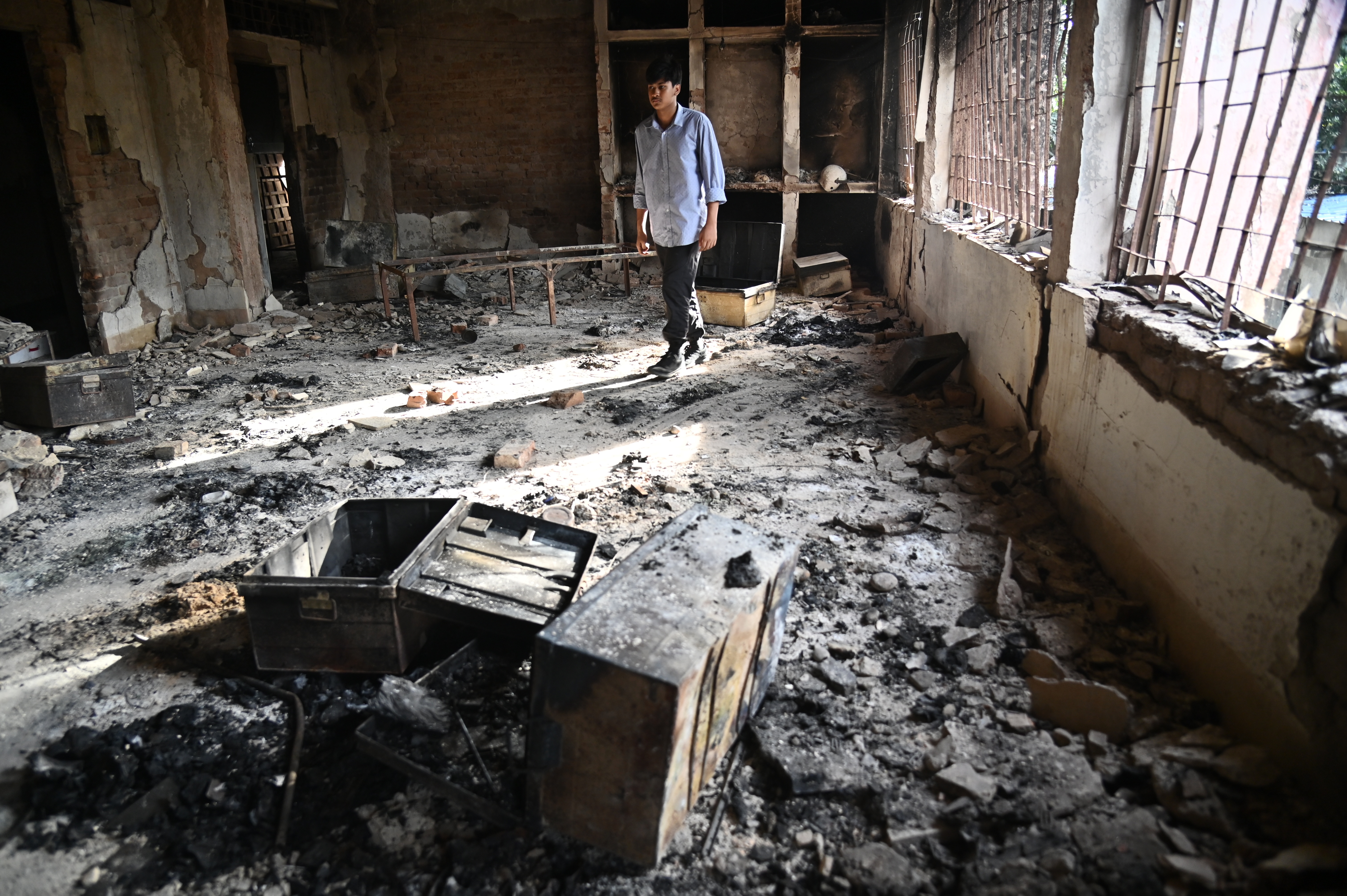
A view from inside the destroyed Mirpur Model Police Station. Photo by S. M. Ariful Amin.
The violence was so intense that senior police officials instructed their officers to evacuate their posts, fearing for their lives. Reports from various police stations across Bangladesh indicate that at least 42 policemen lost their lives as the mob attacked.
By the afternoon of August 6, not one of Bangladesh’s 210,000 police officers was present in any of the police stations across the nation, said the police association.
Assistant Sub-Inspector Mohammed Nura Alam from Gulshan Division recounted the moment they were ordered to abandon their station: “We were instructed to secure our weapons and essential documents and then leave. The situation was too dangerous. We had no choice but to abandon our posts.”
By the end of that fateful day, the whole country was effectively without a police presence. The force, which had once been a pillar of Hasina’s government, had crumbled under the weight of the very public it was supposed to protect.
The absence of law enforcement created a power vacuum that left residents feeling vulnerable and terrified.
Rafiqul Islam, a 60-year-old resident of Karwan Bazar, expressed his fear: “The city is in chaos because of the opposition party’s mobs who are out taking vengeance. There’s no one to protect us. It’s terrifying.”
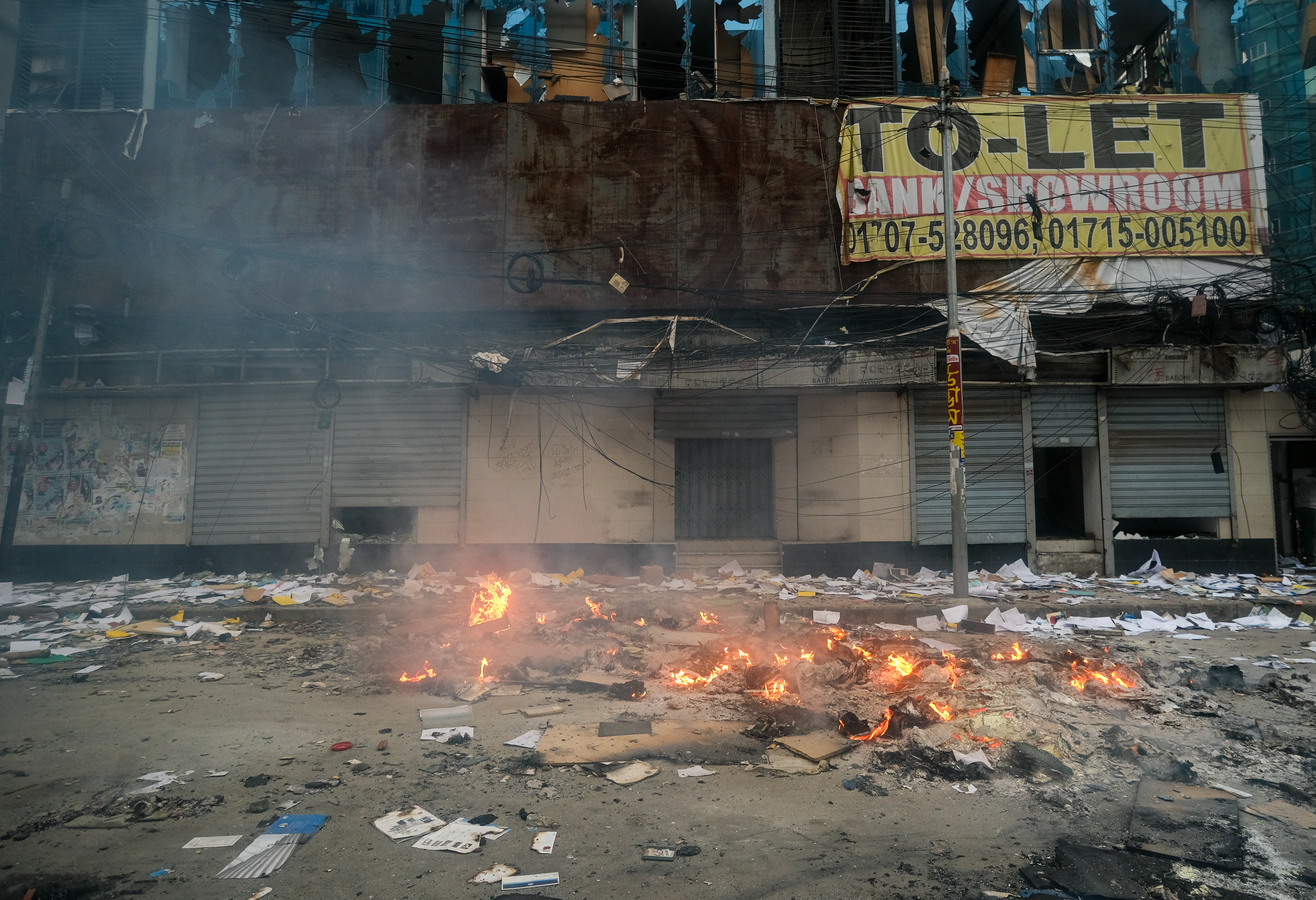
Along with joy vandalism also took place around the country after Hasina’s resignation. Photo by Saqlain Rizve.
In the days that followed, the situation only grew more dire.
Dhaka, already notorious for its traffic woes, was plunged into further disarray as the lack of police presence left the city’s streets unregulated. Ranked as the fifth-worst city in the world for traffic, Dhaka’s situation became even more desperate.
However, in the absence of official law enforcement, ordinary citizens began to step in.
Student volunteers like Abdullah Noman took to the streets nationwide to manage traffic and maintain some semblance of order.
Noman, a young student who protested for the last four weeks and is now determined to reform Bangladesh from its core, remarked, “I couldn’t just stand by and watch everything fall apart for what we protested for. People need to get to work, and to hospitals, and there’s no one else to help. If we don’t step up, who will?”
Meanwhile, the South Asian nation also witnessed a surge in robberies by armed gangs, a phenomenon that has been nearly extinct in Bangladesh many years. With police forces unavailable residents across the capital stepped up to protect their communities through self-organized patrols.
Fearful residents, particularly students, formed night watches and patrolled neighborhoods until police forces reported back to their stations after an ultimatum was issued by Brigadier General (Retd) Sakhawat Hossain, adviser for the Ministry of Home Affairs in the new interim government.
The government, led by Dr. Muhammad Yunus, issued a stern warning to the police in a bid to restore normalcy. Hossain declared that any police officer not reporting for duty by August 8 would be considered unwilling to continue working.
Addressing the public, he urged restraint: “Do not assault the police. You surely understand the necessity of the police. Whether it is the occurrence of robberies or the fear of them, please try to understand the need for the police.”
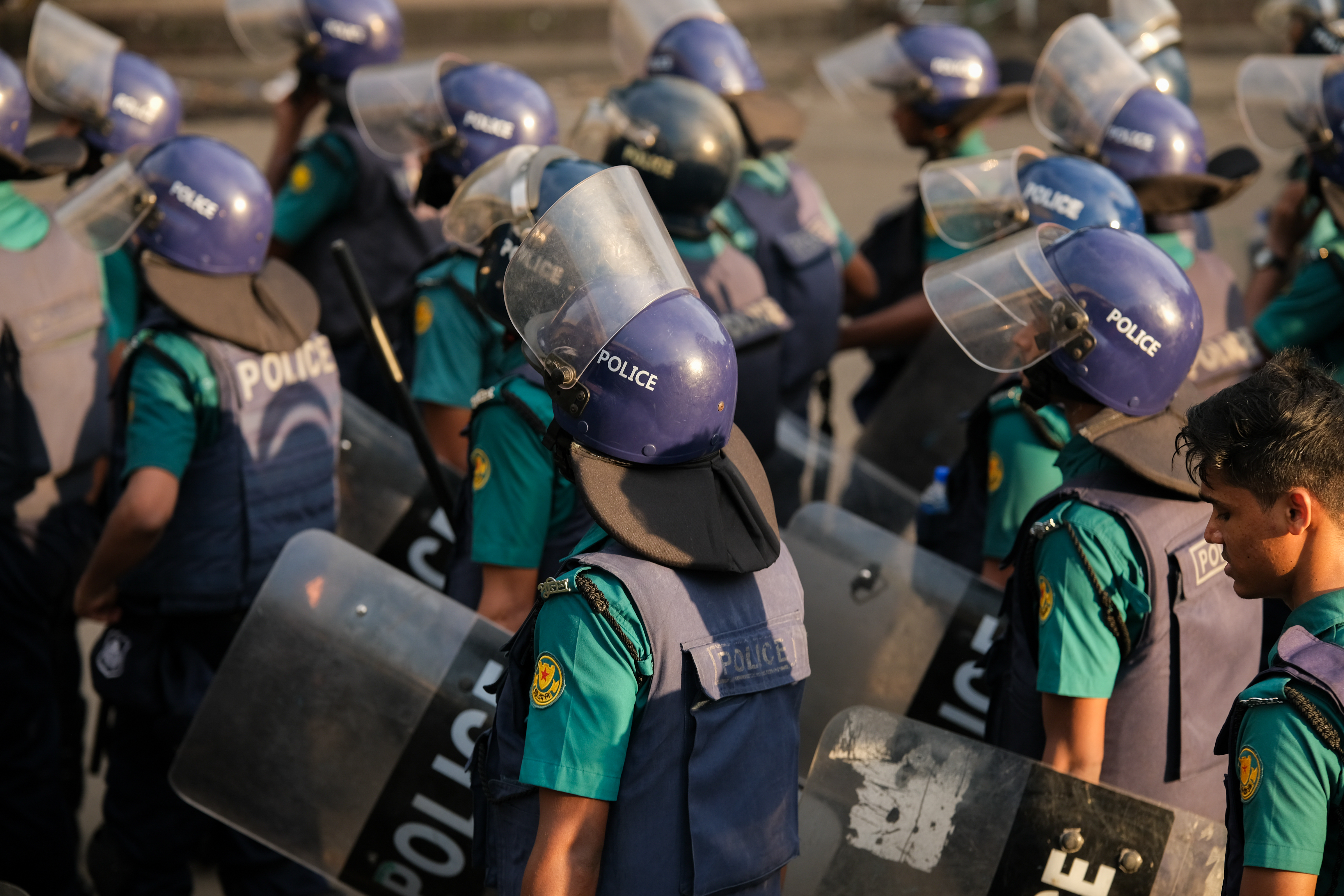
More than half of Bangladesh’s field-level police officers were recruited during Sheikh Hasina’s 15-year tenure, with 105,925 constables and 11,500 sub-inspectors appointed between 2009 and 2023. Photo by Saqlain Rizve.
In response to the crisis, the newly appointed interim government moved quickly to initiate a series of reforms aimed at revitalizing the police.
One of the most visible changes was the decision to alter the police uniform and logo – a symbolic gesture meant to signal a break from the past.
The decision was made during a meeting with the new Inspector General of Police (IGP), Md. Mainul Islam, appointed on August 6, who argued that uniforms play a crucial role in shaping the mindset of officers.
“Uniforms create a mindset. That’s why the change is necessary,” he explained. The hope was that by changing the external symbols of the police force, a corresponding shift in its internal culture would follow.
A committee was formed on August 13 to review and propose changes to the police uniform and logo, with a directive to submit its report within seven working days.
This move, however, was met with skepticism by many, including former police officials who questioned the effectiveness of such superficial changes.
One ex-IGP dismissed the idea that a change in uniform would lead to better performance, particularly in a civilian force like the police.
“I don’t believe there’s a direct connection between what uniform we wear and our performance as a civilian force,” said Mohammad Nurul Huda, who was the police boss during the political transition of 2000-2001. Huda also raised concerns about the costs associated with these changes, especially given Bangladesh’s current economic struggles.
Added to uniform changes, the interim government also began taking internal disciplinary actions against officers who had been involved in the violent suppression of protests. Several senior officials holding key positions were either forced into retirement or reassigned.
Two officers involved in the shooting of unarmed student Abu Sayeed were sent into forced retirement for their roles in the incident.
An additional IGP of Police Headquarters, Md. Tawfiq Mahbub Chowdhury, was appointed as the new head of the Police Bureau of Investigation.
Furthermore, Special Branch Chief and Additional IGP Monirul Islam, along with Criminal Investigation Department Chief Additional IGP Mohammad Ali, were reassigned to non-active roles as Officers on Special Duty.
The shake-up hit DMP the hardest. Twelve superintendents of police were brought in to strengthen the force, while the officers-in-charge of all 50 police stations within the Dhaka Metropolitan Police were transferred to postings outside the capital.
Mainul Islam emphasized the need for transparency and accountability in these actions, stating, “We want to cleanse the force, but we don’t want to cover up anyone’s crimes.”
But the path to reform is fraught with challenges. The issues plaguing the police are deep-rooted and cannot be solved by cosmetic changes alone, said Dr. Mehzeb Chowdhury, a criminalistics expert and criminal law barrister who has worked with over 50 police forces worldwide.
“The force’s long history of political influence and corruption has left it ill-equipped to function as an impartial and professional body. Rebuilding trust will require a fundamental overhaul of the way the police operate and interact with the public,” Chowdhury added.
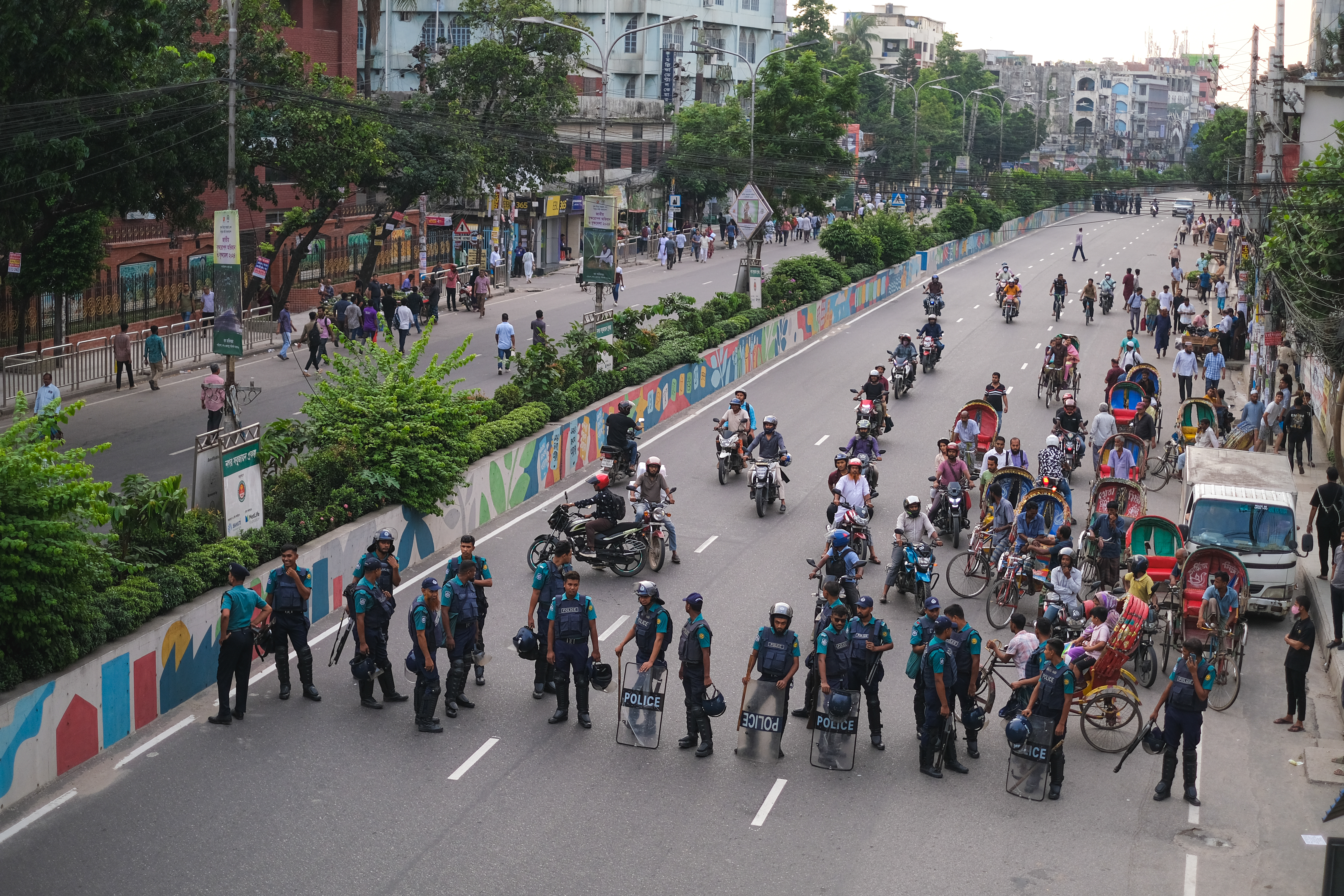
The police block a road during the early phase of the students’ movement on July 8, 2024. Photo by Saqlain Rizve.
A senior police official of the DMP, speaking to The Diplomat on condition of anonymity, acknowledged that “extreme distrust” against the police has been building since 2012, when the police began using widespread force.
He also admitted that the public’s anger has been fueled by behavioral issues within the police force, with all these factors coming to a head simultaneously. “There is no doubt that the current situation is very complex for the police,” he added.
One of the key demands raised by police officers during their nine-point strike, which was declared shortly after Hasina’s resignation, was the need to free the force from political influence.
The officers called for reforms that would allow them to operate independently and professionally, without being used as a tool for political repression.
According to a report by Prothom Alo, more than half of Bangladesh’s field-level police officers were recruited during Sheikh Hasina’s 15-year tenure, with 105,925 constables and 11,500 sub-inspectors appointed between 2009 and 2023. Allegations suggest that many of these appointments were made based on political considerations, with recruits often selected through nepotism and financial transactions.
The Prothom Alo report highlighted that political affiliations were scrutinized before recruitment, and these politically appointed policemen played a key role in suppressing opposition movements during the 2014, 2018, and 2024 national elections.
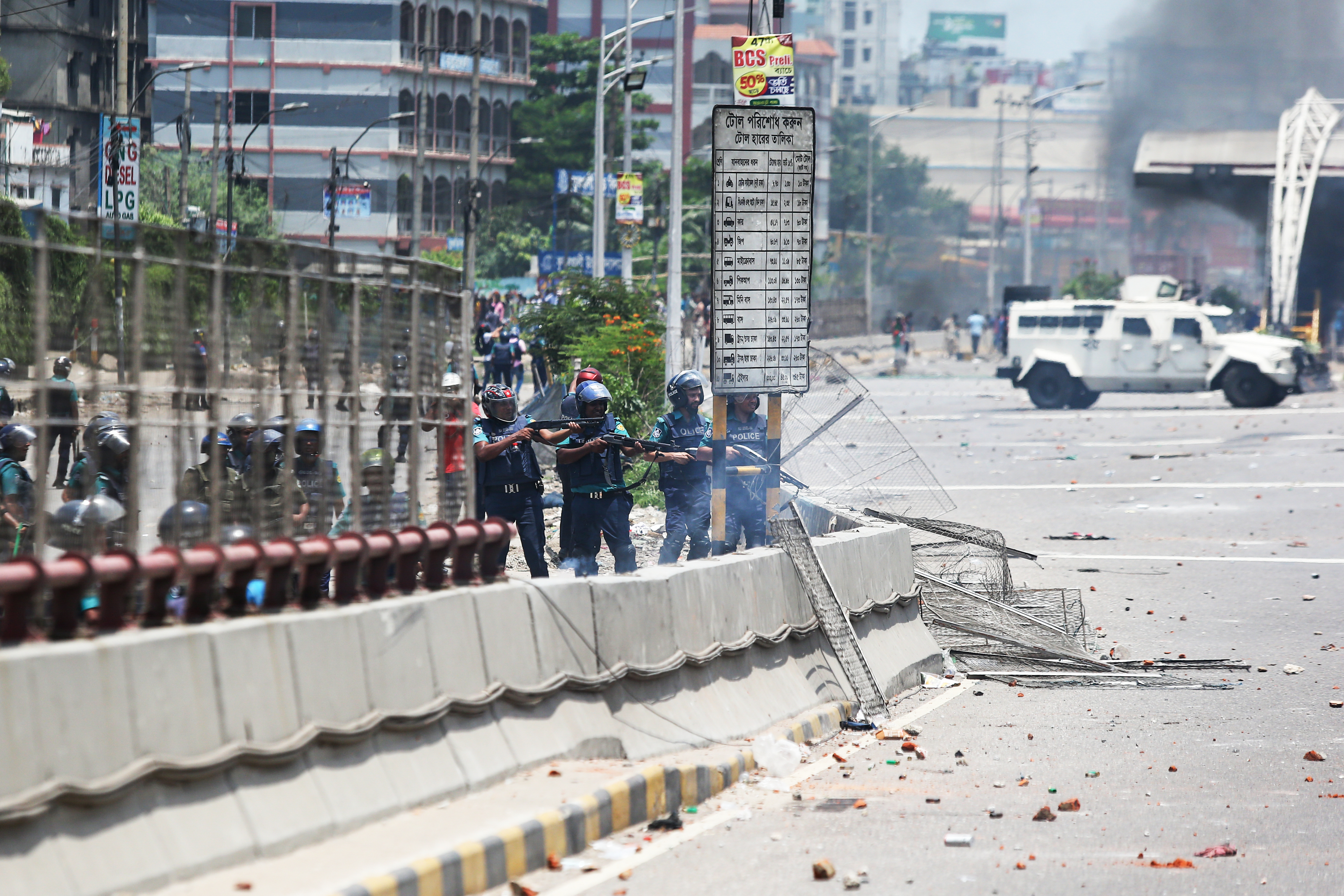
Police personnel firing at protesters in the capital’s Jatrabari area on July 18, 2024. Photo by S. M. Ariful Amin.
Another demand of the police strike was that working hours for police officers must be set at eight hours, in accordance with Bangladesh’s labor laws, with overtime payments provided for additional hours. Many within the force have long complained about being overburdened and under-resourced, leading to high levels of stress and burnout.
The IGP acknowledged this issue, stating, “Efforts are being made to bring working hours in line with international standards and to reduce the burden on officers.”
On August 13, the police headquarters announced that 634 out of 639 police stations across the country had resumed operations. This includes all 110 metropolitan police stations and 524 out of 529 district police stations.
During a gathering held in Dhaka on August 14 a Police Association, composed of officers-in-charge and sub-inspectors from police stations across the country, put forward certain measures to restore public trust in the police.
“The current state of the police is a result of political exploitation and arbitrary orders from senior officials. We need leadership that commands us with the people’s welfare in mind, not one that pits us against the public for political gain,” said Sub-Inspector Md. Zahidul Islam.
“The kind of police officers the student activists are calling for do exist within our department, but they are not allowed to take the lead. These officers should be identified and given the responsibility to guide the Bangladesh Police,” he added.
“Senior officers who have been complicit in causing the deaths of our police officers and ordinary citizens due to their power-hungry and corrupt actions must be arrested and tried under Bangladesh’s existing laws.”













